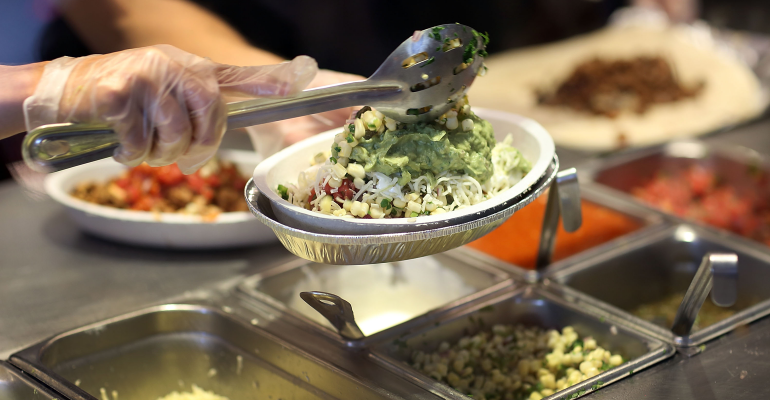Chipotle reported Q2 results Wednesday, including a 7.4% increase in same-store sales, $2.51 billion in revenues (a 13.6% increase), and restaurant-level margins of 27.5% (a year-over-year increase of 230 basis points). The company also opened 47 new restaurants in the quarter, 40 of which included a Chipotlane.
While these numbers were largely positive, they fell short of analysts’ expectations and sent shares tumbling after hours. Still, executives are optimistic, especially given the company’s transaction growth of over 4% – somewhat anomalous as the industry has experienced some traffic flattening and even erosion in recent months against a continued uncertain macroeconomic backdrop.
The chain’s Chicken Al Pastor, introduced in March, drove strong sales, as well as new and repeat customers, according to CEO Brian Niccol, and accounted for one in five orders during the quarter. It also earned the “highest possible social sentiment of any new launch” for the company. The promotion wraps up in late August and executives hinted at a new product coming in its place.
Chipotle also continues to collect Rewards members and surpassed 35 million during Q2. Those customers, Niccol said, spend more and visit more frequently.
“We will continue to look for creative ways to drive enrollment,” he said. One of those ways is to deepen personalized messaging, for example in the app with suggestive sales based on a customer’s order history.
“This goes all the way into cohorts and journeys we create. Customization results in loyalty that results in additional sales,” Niccol said. “The next big step for us is to roll this (personalized communication) out in a way that it covers more people at more scale, so you feel it across the entire enterprise.”
Perhaps the biggest focus during the earnings call, however, was Chipotle’s new equipment tests. The company has rolled out a new dual-sided grill in 10 locations, for instance, that cuts cooking time for both chicken and steak by two-thirds. The grill also provides more opportunity to keep products in stock during peak periods, allows for team members to cook smaller batches for more consistent execution, and produces less waste.
“It also takes one of the most complex positions and reduces the learning curve for that position,” Niccol said. “The double-sided grills … enable cooking times to dramatically decrease, makes the position easier, makes the culinary more consistent and creates more capacity on the Plancha. We’re obviously really excited about what we’re seeing in those 10 restaurants.”
The company is also rolling out new pan rice cookers to streamline the rice-cooking process. Niccol said these new cookers have a faster recovery time, can cook brown and white rice at the same time, and reduce waste. They’re expected to be added to 200 more restaurants this year. And, he touched on Chipotle’s recently announced test of the Autocado with partner Vebu, noting that the exploration of this co-botics system should drive efficiency and ease pain points for team members.
“All of these initiatives have a common goal – to improve the in-restaurant experience for our team members and our guests,” Niccol said.
They’re also expected to improve throughput, which has been a priority for Chipotle for over a year. Niccol said the company has made “some good progress” on its throughput efforts, but much work remains. He noted an example from a New York restaurant patch with a field leader that has trained GMs and crew members to work shoulder-to-shoulder as part of the company’s throughput initiative.
“Just by having that proper deployment with an expo in place, their throughputting improved by nearly five entrees in the peak 15 minutes compared to the prior year,” Niccol said. “There is a real opportunity for not only continued strength in traffic, but also a step up in traffic as we get better at executing throughput.”
On the pricing and inflation, Chipotle executives noted last quarter that the company was done raising menu prices after consecutive increases to offset rising prices across the board, but that could change by the end of this year as it continues to experience “low-grade inflation.” CFO Jack Hartung said prices were higher in Q2 for tortillas, dairy, beef, salsa, beans, rice and some spices, for instance. Those prices, however, were offset by more favorable avocado prices and a mix shift to Chicken Al Pastor, as chicken remains lower than steak.
“Our approach to pricing is it’s a lever we pull and it’s the last thing we like to pull,” Niccol said. “We’re seeing some inflationary pressure both on the labor line and food areas when you pull out avocadoes that we’re looking hard at and, as we get closer to the fourth quarter, we’ll make a decision on what we’ll do on the pricing front.”
In the meantime, executives feel good about the company’s position, its traffic increases, and its consumers across the board.
“The consumer is demonstrating how resilient they are. Both (high-end and low-end consumers) are showing really good strength,” Niccol said. “That’s why we had a strong traffic performance in the quarter and continued to exit with healthy transaction trends. We’re not seeing any weakness, and we’re feeling good about our value proposition for all income levels.”
Contact Alicia Kelso at [email protected]





